Big Five Safaris in Rwanda
Everythg you must know about the big five safaris in Rwanda. If you are heading to Rwanda, the land of a thousand hills for a wildlife safari, you are probably eager to spot the outstanding World of African wildlife, including the iconic Big Five. Firstly, it’s a no-brainer that these animals are Lions, Leopards, Elephants, Buffaloes, and Rhinoceros. Akagera, the largest national park is the only place where you can see these animals in this country. This underrated 1112-square-kilometer Safari destination is on the extreme Eastern side of the country, bordering Tanzania.

Rwanda, a country known for its incredible gorilla trekking safaris is slowly becoming a wonderful destination for Big Five safaris. This comes after the reintroduction of lions in 2015 and Black Rhinos two years later. Rwanda’s Big Five animals live in Akagera National Park, hence you can see them up close and personal. With the outstanding stream of the Big Five roaming freely under the vast skies of Akagera National Park, wildlife lovers are offered consistent and thrilling sightings. These iconic animals are spotted on twice-daily game drives, guided bush walks, or even while relaxing in the comfort of the Lodge. To learn more about these iconic wildlife species, read on. Our articles will help you learn everything you need to know about the Big Five safaris in Rwanda. Feel free to contact us to learn more about these outstanding trips in Rwanda.
Lions
Getting up close and personal with a lion is one of the highlights of a Big Five safari for many safari goers. These animals, known as the “Kings of the Jungle” hunt several small and large animals including bushbucks, Impalas, Kobs, zebras, Impalas, Topis, hartebeests, Buffaloes, and even Giraffes among others. In 2015, Rwanda welcomed 7 lions from South Africa hence making Akagera National Park the first Protected Area in the country to have lions in over a decade. Two years later, more lions were welcomed thus boasting the country’s healthy and growing pride of these big cats.
Thanks to the thrilling lion dynamics, the majority of our Native Africa Tours’ clients have a once-in-a-lifetime opportunity to relish incredible lion sightings during their Big Five safaris in Rwanda. One of the most interesting behaviors that amaze visitors about lions is the fact that the task of hunting is usually left to the lionesses of the pride, who hunt as a team. Being opportunistic feeders, these big cats can capture anything from a mouse to even an elephant or giraffe. Interestingly, they can follow other predators to the location of their kill to steal their food.
A typical male lion is about 1.2 meters tall at the shoulders and can weigh up to 440 pounds/200 kilograms while its counterpart (female) can weigh about 287 pounds/130 kilograms. Cubs are characterized by rosettes and spots and are usually retained by females (especially on their underparts). They are known as non-seasonal breeders but females usually synchronize births and after a gestation of 110 days, 1-4 cubs are born.
Leopards
Known as the second largest of Africa’s big cats, leopards are also common during Big Five safaris in Rwanda. Scientifically known as “Panthera pardus”, these big cats have black spots that are arranged in rosettes, in variance with the yellow-golden backgrounds. They also have single black spots on their head and limbs while their tails are white tipped on the underside.
Leopards are usually mistaken for cheetahs but you can differentiate them by their larger and stockier-built bodies. Males weigh between 20 and 90 kilograms while females are 17 to 60 kilograms. The varied diet of these nocturnal animals makes it possible to adjust to anything, although they feed on small to medium antelopes such as impalas, bushbucks, and Kobs. They also feed on Olive baboons, Hyraxes, and sometimes reptiles. Cubs are born all year round after a three-and-a-half-month gestation period, considering leopards are non-seasonal breeders. Leopards live in a wide range of natural habitats in Akagera National Park- forests, woodlands, bushveld, hills/mountainous areas, and rocky areas.
Rhinoceros
These bold animals are also common during Big Five safaris in Rwanda, having made a historic journey from South Africa to Akagera National Park. In May 2017, African Parks in collaboration with Rwanda Development Board and the Howard G. Buffett Foundation was able to translocate 18 Eastern Black Rhinos to Akagera National Park.
This was followed by the translocation of five more Eastern Black Rhinos from European zoos in 2019. In 2021, African Parks undertook a massive translocation (involving 30 Southern white Rhinos) from South Africa’s andBeyond Phinda Private Game Reserve hence making Akagera National Park a global significant Sanctuary of both black and white Rhinos. Recognized for their prehistoric features as well as horns in their foreheads, these big mammals can surprisingly be spotted grazing right next to lions.
It will interest you to know that Rhinoceros sleep standing up or lying down, and can sleep up to 8 hours a day at intervals. Being herbivorous, they mainly feed on leaves, grasses, fruits, stems and twigs but lack teeth at the front of their mouths. For this reason, Rhinos rely on their lips to pluck food. The black Rhinos prefer feeding at night and during dawn and dusk hours. More so, they always take cover from the scorching sun during the day by resting in the shade. You probably want to know the difference between black and white Rhinos Well, it is mainly from their mouth whereby Black Rhinos’ mouths are hooked and are smaller while white Rhinos’ mouths are wide, in addition to having stockier and massive bodies. Also, the white Rhinos have a reputation for being not as aggressive as the Black Rhinos.
Elephants

Also known as “loxodonta africana”, Elephants are one of the commonest during Big Five safaris in Rwanda. Being the World’s largest mammals, elephants can weigh up to 7 tonnes, with a height of 3.3 meters at the shoulder.
Elephants can live up to 70 years and are known as “voracious feeders” that can consume up to 600 pounds/272 kilometers of food (tree barks, tender shoots, and grass) per day. An adult elephant can drink 200 liters of water per session and can deposit up to 330 pounds/150 kilograms of dung each day. Besides drinking large quantities of water each day, elephants also relish wading or swimming in it hence the reason they enjoy mud baths.
Known for having the longest gestation period of 22 months, a single calf is born after every 3-4 years weighing 100 kilograms. They live in strong family units comprising Bull/s, Cows, Calves, and others. Mature male elephants normally form bachelor groups and become solitary bulls. There are two separate species of elephants (the smaller forest elephants and the African bush elephants), and the latter are the ones you will find in Akagera National Park.
Buffaloes
Herds of Cape buffaloes have an incredible ecological impact on the veld. Also known as African Buffaloes (or Syncerus caffer), these big game are large and powerful with a height of 1.5 meters on their shoulders. They weigh up to 750 kilograms and being bulk grazers, they are responsible for changing long grasslands into short grassy environments that are conducive for other browsers that have selective feeding habits.
Being selective breeders, Cape buffaloes mate between March and May and their gestation period is 330 days, whereby a single calf is born between January and April (or February as the peak). Wounded bulls are known as the most dangerous by hunters, hence one of the reasons why Buffaloes are included in the “Big Five” category.
When is the best time to enjoy Big Five safaris in Rwanda?
Big five safaris in Rwanda are available all year round but the peak season is from June to September because it coincides with the country’s dry season. There are several reasons why it is easier to see the big five during these months.
First, the reduction (or absence) of rains implies that vegetation will dry up and thin out hence making it easier to sight Rhinos or buffaloes compared to the dense and long grasses as well as heavy foliage during the wet months. This also applies to the leopards that spend a lot of time in trees. In the dry season, the trees will have fewer leaves hence making their sleek felines easier to identify.
Also, the reduction of rains in Akagera National Park means the small ponds and other watering points dry up thus forcing wildlife to converge around the remaining large Lakes like Ihema. For this reason, the majority of animals will drink every day to avoid straying too far from the little water that is remaining. This mainly applies to the elephants and lions which usually migrate to the life-giving Lakes like Ihema.
In conclusion, Big Five safaris in Rwanda are a great way to tick your bucket list of meeting lions, leopards, Rhinos, elephants, and buffaloes in the wild. These extraordinary creatures are in Akagera National Park and if you are inspired by our thrilling adventures to see the big five, reach out to our safari specialists today!














